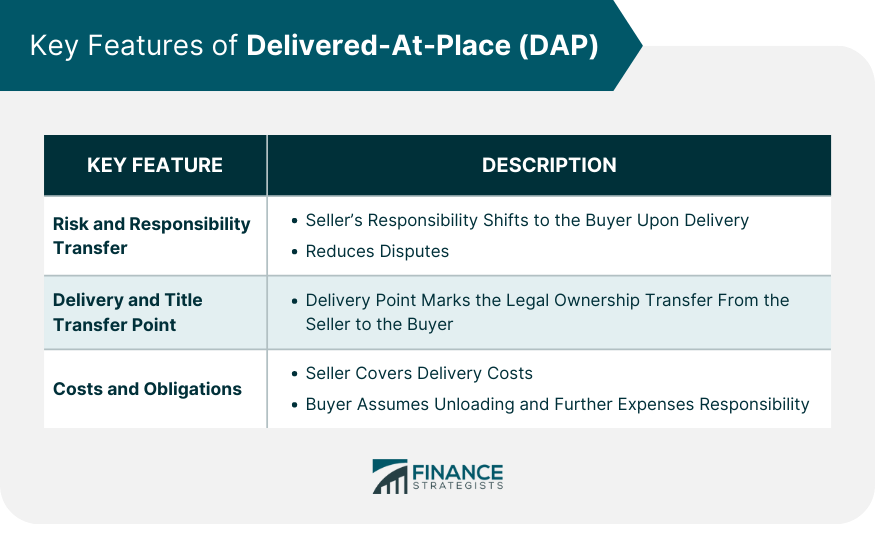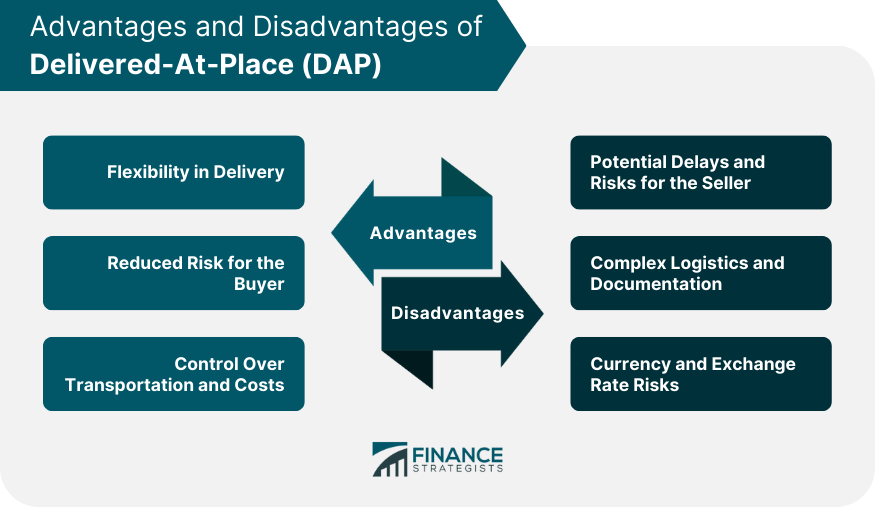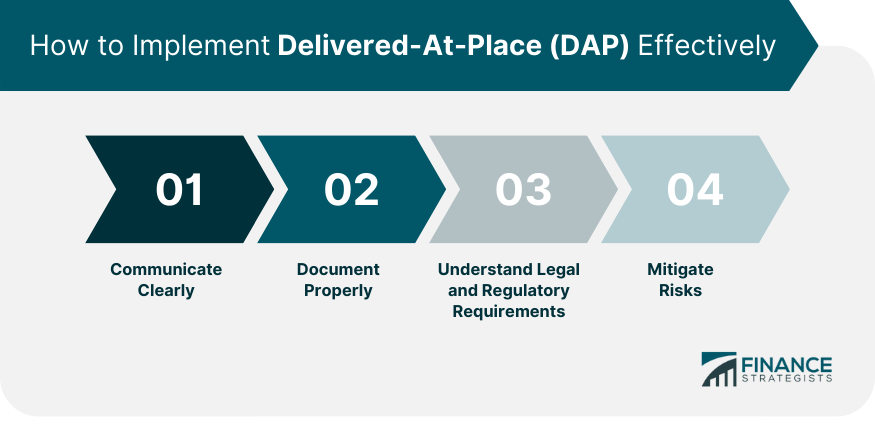Delivered at Place or DAP is a shipping term to signify that the seller of an item is responsible for all costs and potential losses while transporting it from a port of origin to its destination and prior to unloading of the item. Thus, the seller is responsible for costs such as: Transportation charges across land, air, or sea. Export duties Applicable taxes Worker charges to load the given item etc. Sellers aren't accountable for unloading the goods. This point marks the shift in responsibilities from the seller to the buyer. Under the Delivered-at-Place (DAP) agreement, the seller holds responsibility for the goods until they reach their pre-determined destination. The process commences with the seller agreeing to transport goods to a location selected by the buyer. This location could be a port, a warehouse, or even the buyer's premises. The seller bears all costs and risks involved in transporting the goods to the specified destination. This covers all transportation costs, including shipping, insurance, and any duties or taxes imposed during the transit. The obligation of the seller ceases upon the arrival of goods at the agreed location, ready for unloading. At this point, the buyer becomes responsible for the unloading of goods and any subsequent customs procedures if necessary. The seller is not responsible for unloading the item once it reaches the port of destination. Instead, they simply notify the buyer that the goods have arrived at the port of destination and the risk passes on from the seller to the buyer. Thereafter, the buyer pays for import duties and processing charges and transports the item to its final destination. A DAP agreement streamlines the transfer of responsibility from the seller to the buyer at a pre-determined point, minimizing uncertainties and potential areas of conflict during the transportation process. In a DAP agreement, the risk and responsibility for the goods move from the seller to the buyer at a very specific point - when the goods have been delivered at the specified place and are ready for unloading. The explicitness of this point of transfer minimizes ambiguities and potential disagreements between parties. The seller remains responsible for all aspects of the journey until this precise location. Once the goods have arrived and are ready for unloading, all the subsequent responsibilities fall to the buyer. The delivery point in a DAP agreement is not just a geographic location, but also a point of transition in the legal status of the goods. The title to the goods, which is essentially the ownership, is transferred from the seller to the buyer at this point. This makes the agreed upon delivery location a crucial aspect of the DAP agreement. As soon as the goods are delivered at this place and are ready for unloading, the title to the goods transfers from the seller to the buyer. This implies that the buyer gains legal ownership of the goods at this point. In a DAP agreement, all costs associated with delivering the goods to the agreed-upon location are borne by the seller. This includes transportation costs, insurance, and any duties or taxes levied en route. On reaching the designated place, the buyer assumes responsibility for unloading costs and any further costs, such as customs duties for importing the goods. It's essential for both parties to understand and agree on these cost obligations to ensure a smooth transaction. DAP agreements offer significant flexibility in terms of delivery. This flexibility is advantageous for buyers, as they can designate the delivery location as per their convenience. The buyer can select a delivery location that is most convenient and cost-effective for them, be it a port, a warehouse, or their own premises. This flexibility can lead to reduced logistics costs for the buyer, particularly if they are equipped to handle unloading and further transport of the goods from the delivery point. One of the primary benefits of a DAP agreement from the buyer's perspective is the reduction in risk. The seller bears the majority of risks associated with transporting the goods to the delivery point. Until the goods arrive at the designated location, any risks that occur during transit, such as loss, damage, or delay, are the seller's responsibility. This significantly reduces the buyer's risk exposure during the most perilous part of the goods' journey, providing them with considerable peace of mind. A DAP agreement offers a high degree of control over transportation and costs, especially for the seller. The seller is in control of the transportation process until the goods reach the agreed-upon location, allowing them to manage logistics and optimize costs. While this does mean that the seller bears all costs associated with this phase of transport, it also allows them to negotiate with their chosen transport providers, seek out the most cost-effective solutions. The primary disadvantage for sellers under a DAP agreement is the potential for delays and associated risks during transit. Because the seller is responsible for all aspects of transportation until the goods are ready for unloading at the delivery point, they bear all the risks associated with this stage of the process. These risks could include delays due to logistical issues, unforeseen events, or even political situations that can disrupt transport. Such uncertainties can result in increased costs for the seller and may potentially impact their profit margins. The responsibility for arranging transportation, obtaining necessary documents, and ensuring compliance with regulations lies with the seller. This can be a complex process, particularly for smaller businesses or those without a dedicated logistics department. There can be a steep learning curve associated with understanding international shipping laws, customs regulations, and documentation requirements, which may pose a challenge for some sellers. Since DAP agreements involve international transactions, they are subject to fluctuations in exchange rates. In a DAP agreement, the agreed-upon price could be in the seller's currency, the buyer's currency, or a third-party currency. This introduces a degree of uncertainty, as fluctuations in exchange rates can significantly impact the final amount that the seller receives for the goods. Such volatility may pose a significant financial risk for businesses. There are a few strategies businesses can use to implement DAP effectively and reap the maximum benefits from this type of agreement. Clear communication is pivotal to the success of a DAP agreement. Both parties, the buyer and the seller, must be clear about their respective responsibilities, the agreed delivery location, and the costs they will bear. The seller needs to communicate any difficulties or delays during transportation promptly. Similarly, the buyer needs to be clear about the delivery location and ensure that they are ready to receive the goods upon arrival. The seller is responsible for obtaining and providing the necessary documents for transporting the goods, and any mistakes or omissions can lead to delays and increased costs. Sellers must ensure that they have a thorough understanding of the required documentation, and that these documents are complete and accurate. In addition, it's essential to keep copies of all documents as proof of compliance with regulations. To implement a DAP agreement effectively, it's vital to understand the legal and regulatory requirements of the countries involved in the transaction. This could include customs laws, import and export regulations, and specific rules about the goods being transported. Both sellers and buyers should take time to research these requirements, or seek advice from experts or legal professionals if needed. This can help to avoid legal issues and ensure a smoother transportation process. Businesses must have strategies in place to mitigate the risks associated with DAP agreements. This could include purchasing insurance to cover potential losses or damages during transport, or using hedging strategies to manage currency and exchange rate risks. The buyer can also mitigate risks by choosing a delivery location that is convenient and secure, and by being prepared to handle the unloading and further transportation of the goods. DAP is part of the incoterms list published by the International Chamber of Commerce. These terms are used to standardize shipping and freight contracts and avoid lengthy negotiations by expressing contractual obligations in simple phrases. Conceptually, DAP is similar to Carriage Paid To (CPT) and Delivered Duty Paid (DDP) because it assigns seller responsibility for a shipment. However, CPT assigns cost responsibility to sellers until the item is passed onto a carrier or a person nominated by the buyer and DDP makes sellers responsible for importation costs as well. While it aims to assign responsibilities, DAP is not always clear in dividing costs between parties. For example, it is not clear who is responsible for charges caused due to delays in customs processing. Different countries have different timelines and requirements to import products. These can cause delays, leading to demurrage charges. Exporters sometimes use other terms as substitutes to provide greater clarity in cost divisions: Carriage Paid To (CPT) assigns cost responsibility to sellers until the item is passed onto a carrier or a person nominated by the buyer. Delivered Duty Paid (DDP) makes sellers responsible for importation costs in addition to transportation charges. Delivered-at-Place (DAP) is a shipping term that outlines the responsibilities and costs associated with transporting goods from the seller to the buyer. DAP offers flexibility in delivery, reduced risk for the buyer during transit, and control over transportation and costs for the seller. However, it also presents challenges, such as potential delays and risks for the seller, complex logistics and documentation, and currency and exchange rate risks. To implement DAP effectively, clear communication, proper documentation, and a solid understanding of legal and regulatory requirements are essential. Mitigating risks through insurance and hedging strategies can further enhance the efficiency and security of DAP transactions. Businesses must carefully consider their unique circumstances and the potential risks and benefits of DAP before entering into such agreements. Delivered-at-Place (DAP) Definition
DAP Process
Key Features of Delivered-at-Place (DAP)
Risk and Responsibility Transfer
Delivery and Title Transfer Point
Costs and Obligations

Advantages of Delivered-at-Place (DAP)
Flexibility in Delivery
Reduced Risk for the Buyer
Control Over Transportation and Costs
Disadvantages of Delivered-at-Place (DAP)
Potential Delays and Risks for the Seller
Complex Logistics and Documentation
Currency and Exchange Rate Risks

How to Implement Delivered-at-Place (DAP) Effectively
Communicate Clearly
Document Properly
Understand Legal and Regulatory Requirements
Mitigate Risks

Incoterms List
DAP Explanation
DAP Example
Conclusion
Delivered-at-Place (DAP) FAQs
DAP is a shipping term meaning that the seller of an item is responsible for all costs and potential losses while transporting it from a port of origin to its destination and prior to unloading of the item.
DAP stands for Delivered-at-Place.
These terms are used to standardize shipping and freight contracts and avoid lengthy negotiations by expressing contractual obligations in simple phrases.
While it aims to assign responsibilities, DAP is not always clear in dividing costs between parties.
Exporters sometimes use other terms to provide greater clarity in cost divisions: Carriage Paid To (CPT) assigns cost responsibility to sellers until the item is passed onto a carrier or a person nominated by the buyer. Delivered Duty Paid (DDP) makes sellers responsible for importation costs in addition to transportation charges.
True Tamplin is a published author, public speaker, CEO of UpDigital, and founder of Finance Strategists.
True is a Certified Educator in Personal Finance (CEPF®), author of The Handy Financial Ratios Guide, a member of the Society for Advancing Business Editing and Writing, contributes to his financial education site, Finance Strategists, and has spoken to various financial communities such as the CFA Institute, as well as university students like his Alma mater, Biola University, where he received a bachelor of science in business and data analytics.
To learn more about True, visit his personal website or view his author profiles on Amazon, Nasdaq and Forbes.











